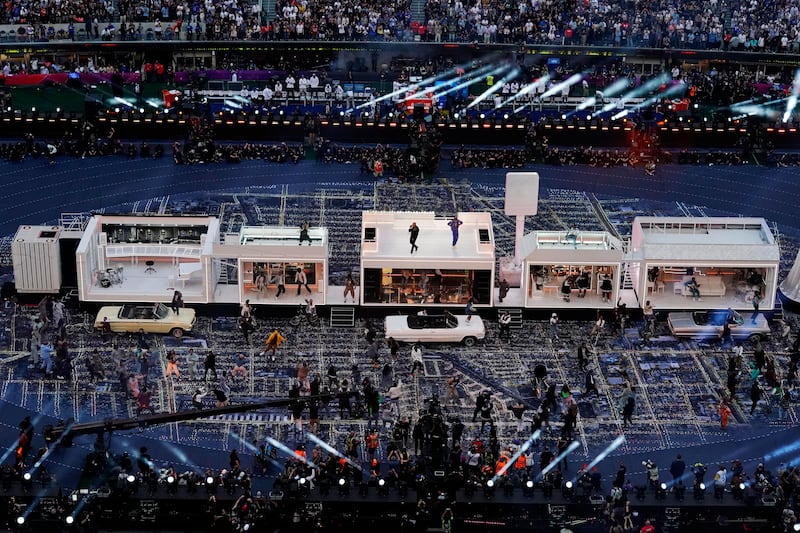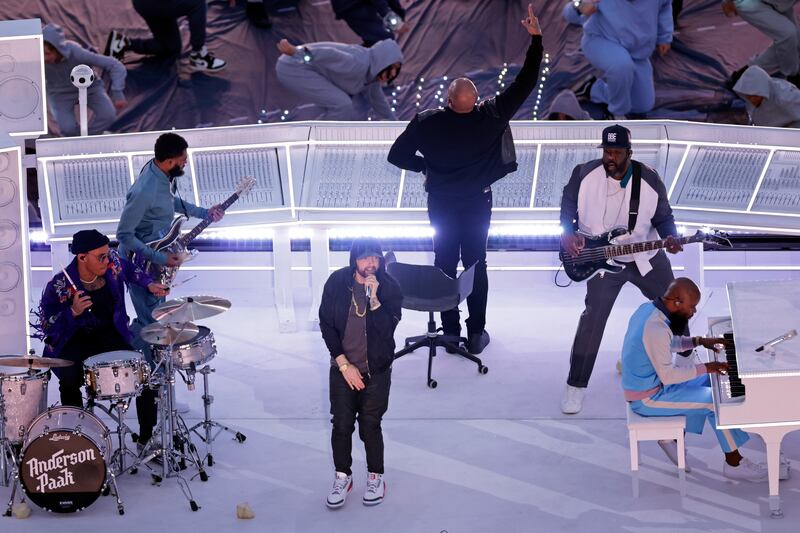This year’s show headlined hip-hop legends Snoop Dogg, Dr. Dre, Kendrick Lamar, Mary J. Blige, Eminem and the surprise (and upside-down) addition of 50 Cent. Each of these artists could have filled an entire halftime show on their own, so letting their prominence shine while not diminishing their presence was a definite challenge. A challenge that the show’s embrace of Black culture through staging, soundtrack and wardrobe emphatically transmitted to over 100 million viewers’ living rooms.
The set was a multidimensional stage featuring mock renderings of LA staples like Dale’s Donuts, Tam’s Burgers and the Compton Courthouse. An ensemble that lends itself to the undertones of the entire show: a celebration of Black culture amid the backdrop of racial injustice. The camera tracked the artists through the stark white stage set from room to room, posturing it like a house for these artists to come home to.

The televised program opened with a map of LA streets superimposed on Dr. Dre’s palm. The map then became the flooring for the entire set as “The Next Episode” boomed over the speakers. Dr. Dre spent the majority of the show behind a mixing board, which is a fitting homage to the transcendence of his iconic beats.
As Mary J. Blige’s reflective wardrobe and silky soul tones claimed their rightful spot among the ensemble, the R&B legend’s two-decades-old classic resounded throughout the stadium reminding the audience that the show really was a “Family Affair.”

Kendrick Lamar’s “Alright” was a nose-scrunching proclamation of the resilience of Black culture. Lamar’s set felt both timely and nostalgic, the blond buzz cuts a likely nod to the 1993 film “The Meteor Man” in which schoolteacher Jefferson Reed, played by Robert Townsend, becomes a superhero and takes on the gang that has been tearing through the D.C. area.
Although the addition of Anderson .Paak on the drums did not feel like a large enough honoring of his talents, his unannounced appearance still brought smiles to those familiar with his work. His presence also represents the innovation of hip-hop through his unique style that charts an exciting future for the genre. Therefore, the show was an ode to the past and a nod to the future.

Every element of the show felt lovingly tended to without ever overdoing it, for example, Snoop’s Dogg’s relaxed walk and accompanying family-like coolness contributed to the comfort and endearment of the show. With representation being integral to the set, having larger-figured Black women as backup dancers was a necessary inclusion, as were the Black male backup dancers whose choreography reflected the signature step routines of Black fraternities.
While the emotional sentiment of the show was significant, the social implications of their performances cannot be ignored. When Colin Kaepernick was left without an NFL contract in 2017 after his acts of protest during the national anthem, many Black artists refused to perform at the halftime show. These boycotts likely stemmed from a combination of Kaepernick being frozen out of the NFL and a gradual build-up of backlash against performers like Janet Jackson and Beyonce, for a wardrobe malfunction and for Black Panther references, respectively. Jay-Z was one of these boycotting artists, yet his entertainment agency oversaw this year’s halftime show, as well as the last two halftime shows. The difference is the way this year’s show centered hip-hop music in a way that had not been done before. The 2022 Super Bowl represents a relaxing of tensions, a convergence of powers to celebrate the impact of hip-hop music through early revolutionaries like Dr. Dre and Snoop Dogg, and more contemporary trailblazers like Lamar.
The show maintained its political relevance, specifically through Eminem’s closing of “Lose Yourself” by taking a knee and Dr. Dre’s line “still not lovin’ police”. However, Lamar’s omission of “po-po” from his famous line “We hate po-po/ Wanna kill us dead in the street for sure” reveals that there are still reservations about the incorporation of political statements in Super Bowl halftime shows. Social advocacy is inextricable from each of these artists’ work, just as it is inextricable from the entire genre of hip-hop, and while some may see the show as a concession, it opens up conversations about race and culture and how those in power are implicated within these realms. The halftime show was a confluence of pride, nostalgia and protest that shined a warm spotlight on Black life and culture.
